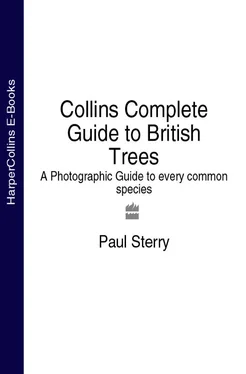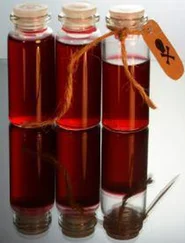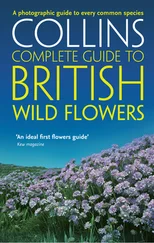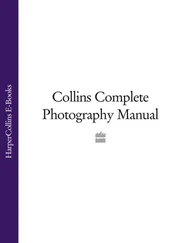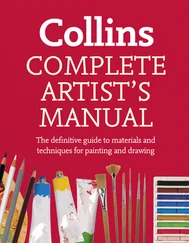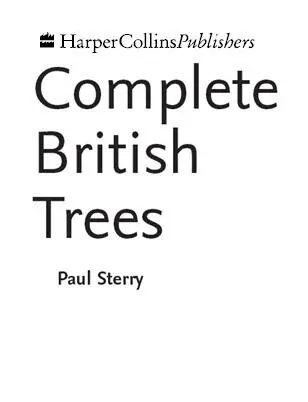

HarperCollins Publishers Ltd.
1 London Bridge Street
London SE1 9GF
The Collins website address is: http://www.harpercollins.co.uk.
Collins is a registered trademark of HarperCollins Publishers Ltd.
First published in 2007
Text © 2007 Paul Sterry
Photographs © Individual photographers as indicated in the picture credits
Paul Sterry asserts his moral right to be identified as the author of this work.
All rights reserved under International and Pan-American Copyright Conventions. By payment of the required fees, you have been granted the nonexclusive, nontransferable right to access and read the text of this e-book on-screen. No part of this text may be reproduced, transmitted, downloaded, decompiled, reverse-engineered, or stored in or introduced into any information storage and retrieval system, in any form or by any means, whether electronic or mechanical, now known or hereafter invented, without the express written permission of HarperCollins e-books.
A catalogue record for this book is available from the British Library.
Source ISBN: 9780007211777
Ebook Edition © MARCH 2015 ISBN: 9780008144593
Version: 2015-04-22
Colour reproduction by Nature Photographers Ltd
HarperCollinsPublishers has made every reasonable effort to ensure that any picture content and written content in this ebook has been included or removed in accordance with the contractual and technological constraints in operation at the time of publication.
The book is dedicated to the memory of Bramley Frith.
Cover
Title Page
Copyright
Dedication
Introduction
How to Use this Book
Glossary
Basic Tree Biology
What is a Tree?
Tree and Shrub Families in Britain and Ireland
Identifying Trees
The Life Cycle of a Tree
Growth Rings and Ageing a Tree in the Field
The Ecology of Trees and Woodland
Fungi, Trees and Woodland
Galls
Mosses, Liverworts and Lichens
Hedgerows
Winter Twigs
Comparing Leaves of Common Trees and Shrubs
Comparing the Bark of Common Trees and Shrubs
Fruits and Seeds
History of Woodland Management
Traditional Timber Uses
How to Use an Oak Tree
Recognising Timber
Places to Visit
Conservation
Species Descriptions
Keep Reading
Further Reading
Index
About the Publisher
Trees and shrubs are such a feature of the British scene that many people take them for granted. However, imagine what the landscape (not to mention the parks and gardens) of Great Britain and Ireland would be like without them and you can begin to appreciate their significance. Indeed, in many ways it is our trees and shrubs, more than other living things, that help define what we think of as the British countryside.
Native tree species have an ecological significance that goes beyond their individual presence. The role they play in the ecology of our native woodlands particularly fascinates me, perhaps more than their appearance. So I make no apologies for this book being biased in favour of native species. However, introduced trees and shrubs also have a role to play in today’s world. Some are widely naturalised, many soften our otherwise often brutal urban landscapes and still more are familiar and valued features of mature gardens. Consequently, I have included a wide range of familiar planted species, along with a selection of more unusual or exotic trees and shrubs mostly associated with collections and arboreta.
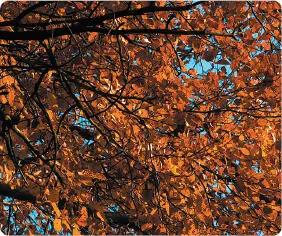
Whether planted or growing in the wild, the Common Beech produces autumn colours that cannot fail to lift the spirits.
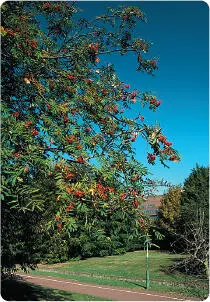
Known best for its colourful berries, the Rowan is widely planted in urban settings and is a welcome sight in autumn.
My personal interest in trees and shrubs extends beyond enjoyment of trees for their own sake and their role in our ecology. I am also fascinated by the uses of timber and tree products in woodland crafts and traditional practices. Sections of the book reflect this interest.
THE REGION COVERED BY THIS BOOK
The region covered by the book comprises the whole of mainland England, Wales, Scotland and Ireland, as well as offshore islands including the Shetlands, the Orkneys, the Hebrides, the Isle of Man, the Isles of Scilly and the Channel Islands.
The coverage of the book is restricted mainly to what most people understand to be trees and larger shrubs; the former are usually defined as single-boled plants with a trunk that exceeds 5m, while shrubs are typically multi-stemmed. However, for the sake of completeness, and as a minor self-indulgence, I have also included native members of tree groups such as willows and birches that should not qualify for inclusion, in the strict sense, on the grounds that they are too small.
Complete British Trees will enable amateur naturalists to identify all native and widely naturalised tree and shrub species found growing wild in the British countryside. With an eye to the exotic, it also allows naturalists and gardeners alike to identify ornamentally planted trees, and to anticipate what any given specimen tree will look like if bought and planted. I hope that the range of popular garden species included in the book helps in this regard.
The book has been designed so that the text and photographs for each species are on facing pages. A system of labelling clearly identifies each tree or shrub. The text complements the information conveyed by the photographs. By and large, the order in which species appear in the main section of the book roughly follows standard botanical classification. However, because parts of the field are in a state of flux, the order may differ slightly from that found in other guides, past, present or future.
At the start of each species description the most commonly used and current English name is given. My primary source of reference for this, and for scientific names, has been Clive Stace’s New Flora of the British Isles . Essentially this covers native and widely naturalised British species. For non-native garden trees and shrubs I have followed the naming employed by Owen Johnson in Collins’ Tree Guide .
Читать дальше
